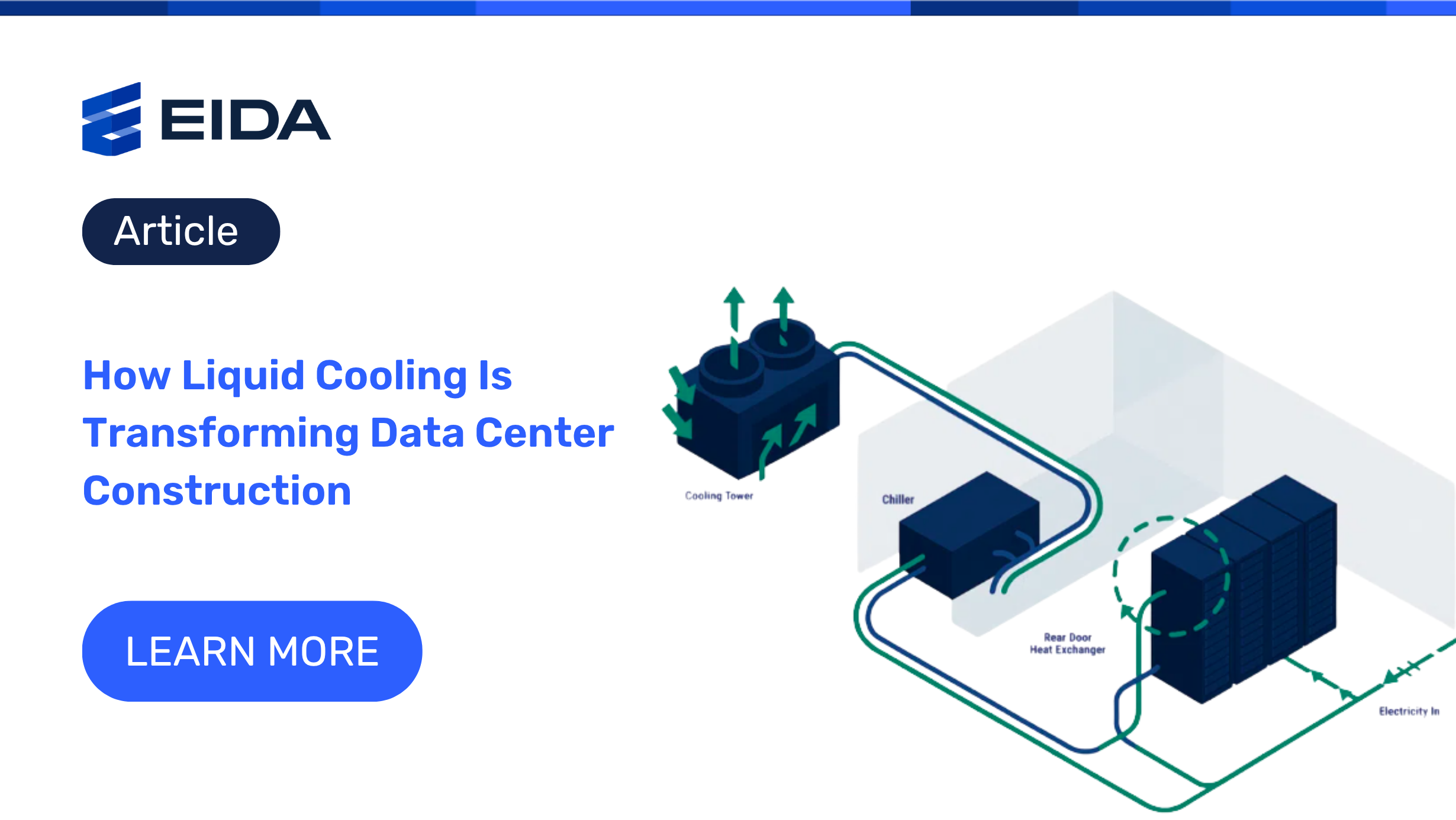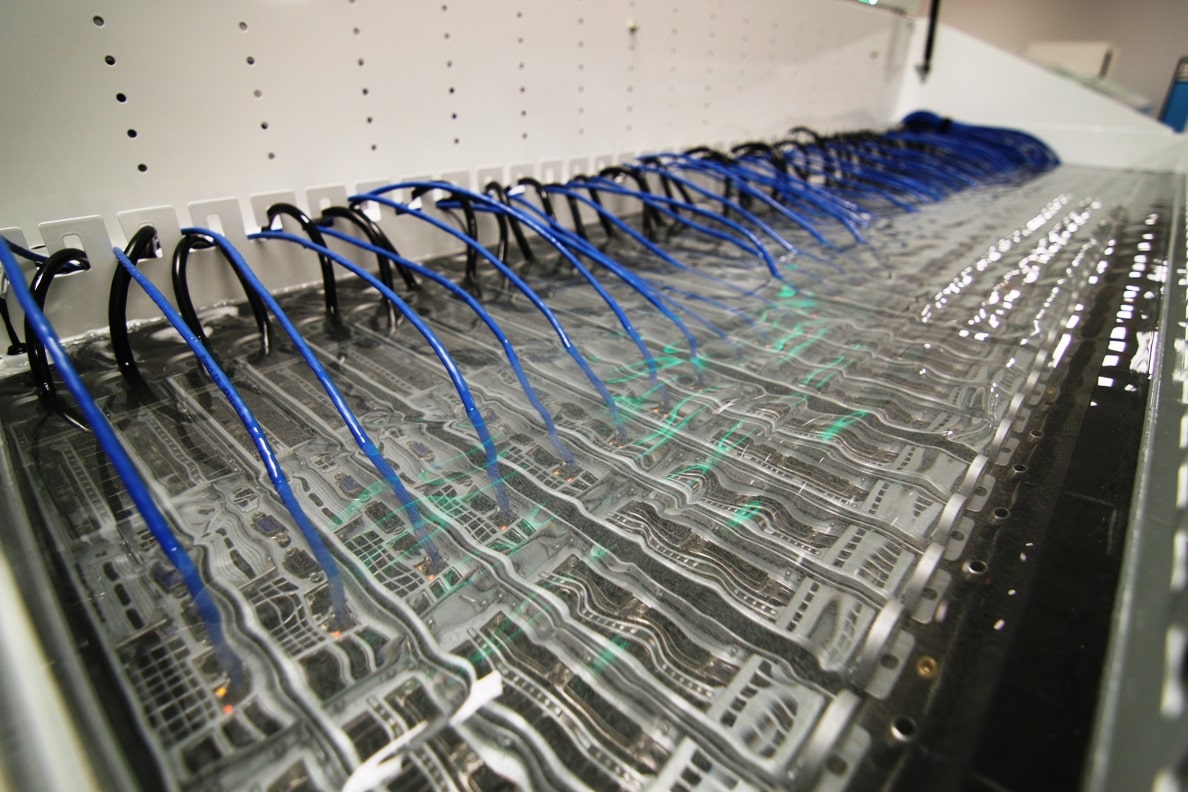
As AI, high performance computing (HPC), and edge networking surge in demand worldwide, traditional data center designs are reaching their limits particularly when it comes to the hyperscale facilities. At the center of this disruptive transformation is a shift in how facilities are cooled, moving from traditional air cooling to liquid cooling. When it comes to high density workloads, air cooling can be less effective than liquid cooling. This is because air has a lower capacity to carry heat away.
It’s a significant change and has required a fundamental rethinking of how data centers are designed, built, commissioned, and turned over. To keep up and stay ahead, end clients and contractors need more than new engineering techniques, they need smarter tools. A comprehensive construction management, commissioning, and turnover software platform like EIDA is becoming essential to successfully deliver these increasingly complex facilities.
What is liquid cooling?
Liquid cooling is a method of managing heat in IT equipment such as servers by using liquids like water or specialised coolants to absorb and dissipate heat. While there are several variations of liquid cooling used in data centres, the approach is especially effective for high density computing environments.

The rise of liquid cooling in data centres
Recently we have seen that the legacy air cooling systems can no longer handle today’s server heat loads, especially with dense GPU clusters and AI workloads pushing racks to 30-100 kW and beyond. The heat emission is enormous and with liquid cooling whether it’s via direct-to-chip (D2C), immersion, or rear-door heat exchangers, there are some important key benefits. These include a much superior thermal performance for the high density racks and a reduced reliance on the HVAC infrastructure. It also requires a much lower energy consumption which improves sustainability and will reduce costs and carbon emissions. This all plays its part in making liquid cooling not a future technology or strategy but a present day requirement in a lot of cases.
How liquid cooling changes construction
So how is liquid cooling changing the construction process for data centers? The first area is the mechanical systems and how they are being redesigned. For all its benefits liquid cooling does introduce new layers of complexity. For example, coolant distribution units (CDUs), piping networks, and specialised manifolds need to be integrated at the rack level. Because liquid cooling enables higher densities per rack, electrical systems must also scale accordingly and power delivery systems (PDUs, UPSs, transformers) need to support greater localised loads. This is combined with redundancy and failover systems requiring new strategies for both cooling and power.
Mechanical, plumbing, and HVAC systems also have to be redesigned to support liquid infrastructure rather than airflow-based models along with new designs for raised floors and hot/cold aisle containment. What this all means is that projects will need at least 2–3x more linear footage of piping for liquid cooled systems in the higher density environments. The implications are higher material and logistical costs, the need for more specialised labour and trades and some of the very basics of more piping welds needing to be made, tracked, tested and put through commissioning.
Liquid cooling hardware and supporting infrastructure (like CDU skids or modular cooling blocks) often come with longer lead times and more precise installation requirements. As a result the installation sequencing changes, the trade coordination becomes more complex and the commissioning and startup processes are more complicated.

Why construction management software is now essential
Delivering a liquid cooled data center is a fast paced endeavour that has become more highly regulated, and needs to be built with far more precision. To achieve this requires real time coordination between mechanical, electrical, IT, QA/QC, and commissioning teams.
Here’s where a construction management, commissioning, and turnover software like EIDA plays a pivotal role and can deliver the following:
Enhanced project efficiency & coordination
- One centralised platform for project tracking, task management and documentation.
- A unique platform enabling trade contractors to track pipework fabrication and installation
- Streamlined communication between stakeholders (clients, contractors, subcontractors, and engineers etc).
- Real-time updates reducing delays and rework.
Improved quality & compliance
- Ensures adherence to industry regulations with a clear, consistent GMP process. The platform requests, auto-checks and guides on complete data entry ensuring all is entered correctly before the user proceeds to the next step.
- Digital checklists and workflows enforce quality control and standard operating procedures.
- Human errors are reduced through automation.
Advanced commissioning & turnover processes
- Full commissioning processes and logic powering project Go Live.
- Customisable digital checklists ensure all required commissioning checks are carried out in full, improving accuracy and reducing paper-based inefficiencies.
- Streamlines turnover with organised, easily accessible documentation and historical data.
- A crucial deliverable for any data centre project, System Turnover is linked to all other platform features, reporting on multiple aspects of construction including VTOP’s and ETOP’s.
The transition to liquid cooling is not just an engineering challenge, it’s a construction one. And in an industry where time to market and reliability are extremely important, you can’t afford outdated tools, spreadsheets or manual processes. Modern construction management, commissioning and turnover platforms are no longer a “nice to have”, they’re the backbone of successful data centre delivery in the age of liquid cooling.
So to sum up, to build the next generation of data centres, clients, contractors, and engineering teams need:
- Deep technical understanding of liquid cooling systems
- Flexible and scalable infrastructure designs
- Buy-in and ambition to deliver the next generation of data centers
- And most importantly, construction technology like EIDA that can manage complexity, coordinate trades, provide schedule certainty and ensure right first time delivery.
Discover how a fully integrated platform can help you deliver liquid cooled facilities faster, smarter, and more reliably with a no obligation demonstration with one of our experts today.


